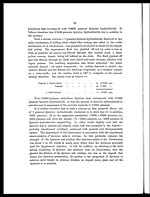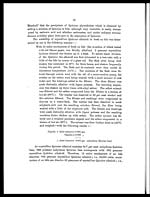Medicine - Institutions > Army health reports and medical documents > Scientific memoirs by officers of the Medical and Sanitary Departments of the Government of India > Number 41 - Quinine and its salts > Quinine and its salts : their solubility and absorbability
(21) Page 11
Download files
Individual page:
Thumbnail gallery: Grid view | List view

11
The action of Quinine salt solutions on blood-serum reminds one strongly
of that of alcohol, which in greater concentration than 33 per cent. is quite
incompatible with blood-serum but in greater dilution perfectly miscible.
Solubility of Quinine Alkaloid in Ox Blood=Serum.
With 25 cubic centimetres of ox blood-serum, fresh and centrifuged, .1
gramme crystalline Quinine alkaloid was shaken up in a flask and incubated
at 37° C. for two hours, during which time the flask was frequently shaken.
After these two hours, the flask and its contents were allowed to cool at
laboratory temperature (12° C.), and then the contents were filtered through
cotton wool with the aid of a water-suction pump. The amount of alkaloid in
solution in the clear filtrate was determined as follows:—
The filtrate was made distinctly alkaline with liquor potassæ and the
resulting suspension thrice shaken up with ethyl æther. The æther extracts
were then filtered and the æther evaporated. The residue was dissolved in 60
per cent. alcohol and this solution filtered into a weighed porcelain capsule.
The filtrate and washings were evaporated on a water-bath, avoiding boiling,
and the residue dried at 120° C. and weighed. The following figures were
obtained:—
| Capsule + dried residue | = | 12.474 gm. |
| Capsule | = | 12.440 ,, |
| = | 0.034 gm. (anhydrous Quinine base). |
Now, crystalline Quinine alkaloid contains 85.7 per cent. anhydrous Qui-
nine base; therefore, 0.034 gramme anhydrous Quinine base corresponds with
.0397 gramme crystalline Quinine alkaloid. Thus .0397 gramme crystalline
Quinine alkaloid was dissolved in 25 cubic centimetres of ox blood-serum,—i.e.,
practically 4 parts in 2,500 parts of serum or 1 in 625. Crystalline Quinine
alkaloid is therefore nearly three times as soluble in ox blood-serum as in water.
Solubility of Quinine Alkaloid in Ox Bile,
Malanin1 in 1868 demonstrated the insolubility of the compounds formed
by the union of Quinine and bile acids and assumed from this that the intestines
took little or no part in the absorption of Quinine. A similar action was
attributed to bile acids by Kerner.2 Lauder Brunton,3 while acknowledging
the sparingly soluble character of the precipitate obtained by adding Quinine
to bile acids, refers to its solubility in an excess of bile. The opinion expressed
by Dixon7 is that after entering the duodenum Quinine is under ordinary
circumstances absorbed rapidly; but if there is excess of alkali in the
duodenum Quinine is precipitated, forming with the bile acids insoluble salts
which are passed unchanged in the fæces. It is, however, pointed out by
D
Set display mode to: Large image | Zoom image | Transcription
Images and transcriptions on this page, including medium image downloads, may be used under the Creative Commons Attribution 4.0 International Licence unless otherwise stated. ![]()
| Permanent URL | https://digital.nls.uk/75034214 |
|---|
| Description | Their solubility and absorbability by A.C. MacGilchrist. |
|---|---|
| Shelfmark | IP/QB.10 |
| Additional NLS resources: | |




